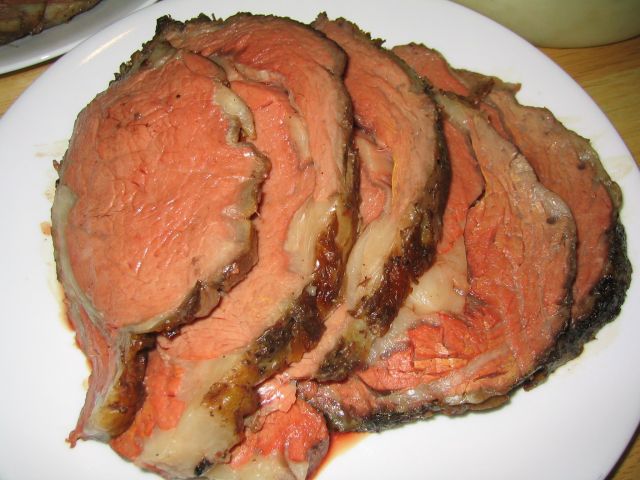3/2/07
 Some of you may remember a few months ago when I posted a blog called “Ask Dr. Jett,” in which I pretended to know what I was talking about, medical-wise. In that same vein, I bring you some common culinary questions which we will pretend were asked of me by…someone. Enjoy, dear readers.
Some of you may remember a few months ago when I posted a blog called “Ask Dr. Jett,” in which I pretended to know what I was talking about, medical-wise. In that same vein, I bring you some common culinary questions which we will pretend were asked of me by…someone. Enjoy, dear readers.Q: What is that red liquid that comes out of packaged meat? Is…is that blood?!
A: No. Sorry, vampires in training; were you to rely upon packaged meat from your local supermarket for sustenance you would quickly starve to death. Fresh meat contains only trace
 amounts of blood; almost all is removed from the tissue shortly after slaughter. The red liquid you see in the package and what runs out when you cut into a nice, medium rare prime rib is mostly water, dye, proteins and myoglobin. Myoglobin is the primary oxygen-carrying pigment of muscle tissues. [1] It contains a large amount of amino acids and iron, which makes it red, but it is not blood-borne like its structural cousin, hemoglobin.
amounts of blood; almost all is removed from the tissue shortly after slaughter. The red liquid you see in the package and what runs out when you cut into a nice, medium rare prime rib is mostly water, dye, proteins and myoglobin. Myoglobin is the primary oxygen-carrying pigment of muscle tissues. [1] It contains a large amount of amino acids and iron, which makes it red, but it is not blood-borne like its structural cousin, hemoglobin.Just a little knowledge to drop on the next lunatic who orders his steak fried into a charcoal cinder because he “doesn’t want to eat blood,” or some such other pussified malarkey.
Q: Every time I boil an egg, I end up with a yolk that’s all green around the outside and shit. How can I avoid this culinary faux-pas when preparing deviled eggs for my church group?
 A: Everybody knows you don’t go to church; what are you trying to pull, here? The fact that you’re a horribly liar aside, that green discoloration that your seeing on your egg yolks comes from cooking the bejezzus out of them. The green is a chemical reaction between the iron of the yolk and the sulfur of the egg white. It’s harmless and tasteless, but rather an eye-sore.
A: Everybody knows you don’t go to church; what are you trying to pull, here? The fact that you’re a horribly liar aside, that green discoloration that your seeing on your egg yolks comes from cooking the bejezzus out of them. The green is a chemical reaction between the iron of the yolk and the sulfur of the egg white. It’s harmless and tasteless, but rather an eye-sore.You’ve probably been conditioned from childhood to cook your eggs in boiling water for at least ten minutes in order to assure that they are as hard-boiled as Sam Spade. This is a mistake; what you end up with is overcooked eggs straight out of Dr. Seuss. I don’t know if you’re afraid of the eggs escaping, or if it’s salmonella that keeps you pumping enough radiant energy into your poultry embryos to ignite a fusion reaction, but trust that neither is likely. There is almost no chance of contracting salmonella from eggs, and in the remote possibility that you could, the following method kills it off and leaves you with a perfectly cooked, green-less eggs.
1. Put eggs into a pot with enough cold water to completely cover them; if you’re really loading the pot you may want to leave an inch of water over their heads.
2. Put over high heat until water comes to a rolling boil.
3. Turn off heat and cover the pot. Just let it sit there for ten minutes…go masturbate or shoot-up or something.
4. Run cold water over eggs until they are cool to the touch.
5. Peel and enjoy the eggy goodness.
Q: My wife has just served me pork which is pink in the center. Why is she trying to murder me?
A: Well, you’re not very likable, you have no job, and you make love like an angry elephant seal; reason enough? Or it could be that your significant other has a more extensive understanding of our delectable porsine brethren than you do, you ignorant oaf.
Sorry to fly off the handle like that. At any rate, pork, especially the leaner loin and chop cuts, is like poultry in that you have to walk a narrow line between having a sufficiently cooked and juicy meat, and something that is safe, but tastes like it’s been substituting for the sole of your shoe all day long. The thing that people fear from pork is trichinosis. The CDC recommends either freezing your pork for 20 days at 5˚F, or cooking the meat to a staggering internal temperature of 170˚F. Trouble is, at that temp the pig sort of turns into a hot, dry slab resembling a cork coaster in both texture and flavor.
 The CDC is erring on the side of caution, because trichinosis is killed at only 144˚F. Cooking your pork to 150-155˚F (medium to med-well) will ensure a moist, juicy and safe piece of meat. Besides, let’s not forget that the food continues cooking even after taken off the heat; large cuts of meat can increase their internal temperature by 5-15˚F just sitting on the counter.
The CDC is erring on the side of caution, because trichinosis is killed at only 144˚F. Cooking your pork to 150-155˚F (medium to med-well) will ensure a moist, juicy and safe piece of meat. Besides, let’s not forget that the food continues cooking even after taken off the heat; large cuts of meat can increase their internal temperature by 5-15˚F just sitting on the counter.In the past 10 years there have been fewer than 5 cases of trichinosis reported in the United States, and nearly all of them were because of eating undercooked wild or game meat, which has a higher risk of the parasite.
Long story short: Lay off the old lady; pink in a portion of pork is positively perfect. Alliteration, suck’a’s!
[1] Wikipedia – Myoglobin

No comments:
Post a Comment